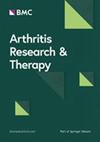SDF-1 alleviates osteoarthritis by resolving mitochondrial dysfunction through the activation of the Sirt3/PGC-1α signalling pathway
IF 4.9
2区 医学
Q1 Medicine
引用次数: 0
Abstract
Osteoarthritis (OA) is the most common form of joint disease. Currently, OA treatment is limited to controlling symptoms. Our previous study showed that stromal cell-derived factor 1 (SDF-1) delayed the progression of OA to a certain extent. The aim of this study was to explore the specific mechanism of SDF-1 in OA. OA chondrocytes and a collagen-induced osteoarthritis (CIOA) mouse model were used as in vitro and in vivo models, respectively. SDF-1 was used to treat OA in vitro and in vivo. To explore the mechanism of SDF-1 in OA treatment, we pretreated chondrocytes with a Sirt 3 inhibitor and assessed mitochondrial function and then analysed related indicators of cartilage anabolic and cartilage metabolism. SOD2 and PGC-1α levels were significantly lower in OA chondrocytes and the cartilage of CIOA model mice than in normal chondrocytes, and mitochondrial dysfunction occurred in OA. After treating OA chondrocytes and CIOA model mice with exogenous SDF-1, mitochondrial dysfunction and abnormal biomarkers of OA normalized. The pretreatment of OA chondrocytes with a Sirt 3 inhibitor or mitochondrial function inhibitor before SDF-1 exposure reversed these changes. SDF-1 can alleviate OA by resolving mitochondrial dysfunction through the activation of the Sirt3/PGC-1α signalling pathway, and therefore, SDF-1 may be a good candidate as a new treatment for OA.SDF-1通过激活Sirt3/PGC-1α信号通路解决线粒体功能障碍,从而缓解骨关节炎
骨关节炎(OA)是最常见的关节疾病。目前,OA的治疗仅限于控制症状。我们前期研究发现基质细胞衍生因子1 (SDF-1)在一定程度上延缓了OA的进展。本研究旨在探讨SDF-1在OA中的具体作用机制。骨性关节炎软骨细胞和胶原诱导骨性关节炎(CIOA)小鼠模型分别作为体外和体内模型。SDF-1用于体外和体内治疗OA。为了探讨SDF-1在OA治疗中的作用机制,我们用sirt3抑制剂预处理软骨细胞,评估线粒体功能,然后分析软骨合成代谢和软骨代谢的相关指标。OA软骨细胞和CIOA模型小鼠软骨中SOD2和PGC-1α水平明显低于正常软骨细胞,OA出现线粒体功能障碍。外源性SDF-1治疗OA软骨细胞和CIOA模型小鼠后,OA线粒体功能障碍和异常生物标志物恢复正常。在暴露于SDF-1之前,用sir3抑制剂或线粒体功能抑制剂预处理OA软骨细胞可逆转这些变化。SDF-1可以通过激活Sirt3/PGC-1α信号通路解决线粒体功能障碍,从而缓解OA,因此,SDF-1可能是OA治疗的新候选药物。
本文章由计算机程序翻译,如有差异,请以英文原文为准。
求助全文
约1分钟内获得全文
求助全文
来源期刊

Arthritis Research & Therapy
RHEUMATOLOGY-
CiteScore
8.60
自引率
2.00%
发文量
261
审稿时长
14 weeks
期刊介绍:
Established in 1999, Arthritis Research and Therapy is an international, open access, peer-reviewed journal, publishing original articles in the area of musculoskeletal research and therapy as well as, reviews, commentaries and reports. A major focus of the journal is on the immunologic processes leading to inflammation, damage and repair as they relate to autoimmune rheumatic and musculoskeletal conditions, and which inform the translation of this knowledge into advances in clinical care. Original basic, translational and clinical research is considered for publication along with results of early and late phase therapeutic trials, especially as they pertain to the underpinning science that informs clinical observations in interventional studies.
 求助内容:
求助内容: 应助结果提醒方式:
应助结果提醒方式:


